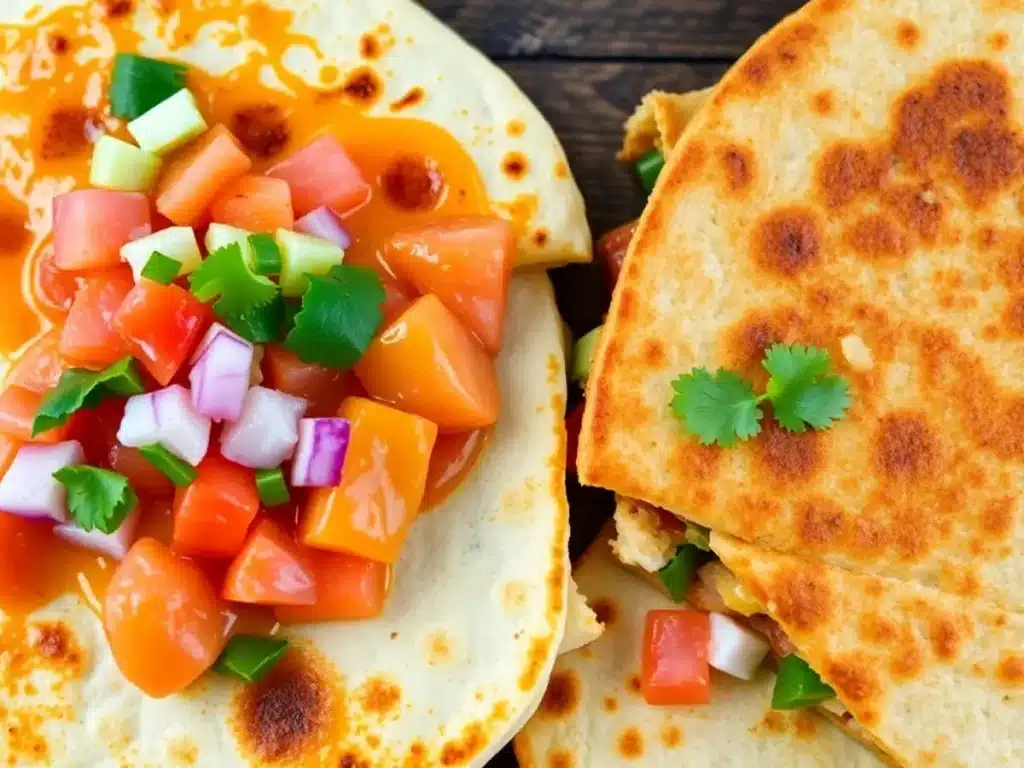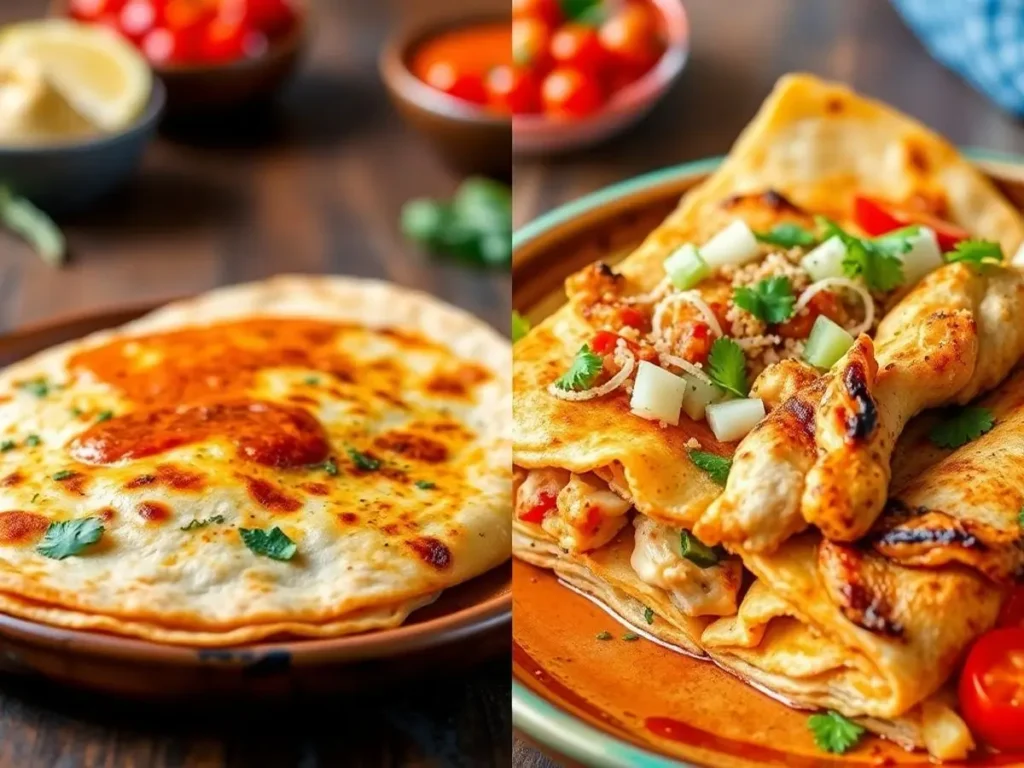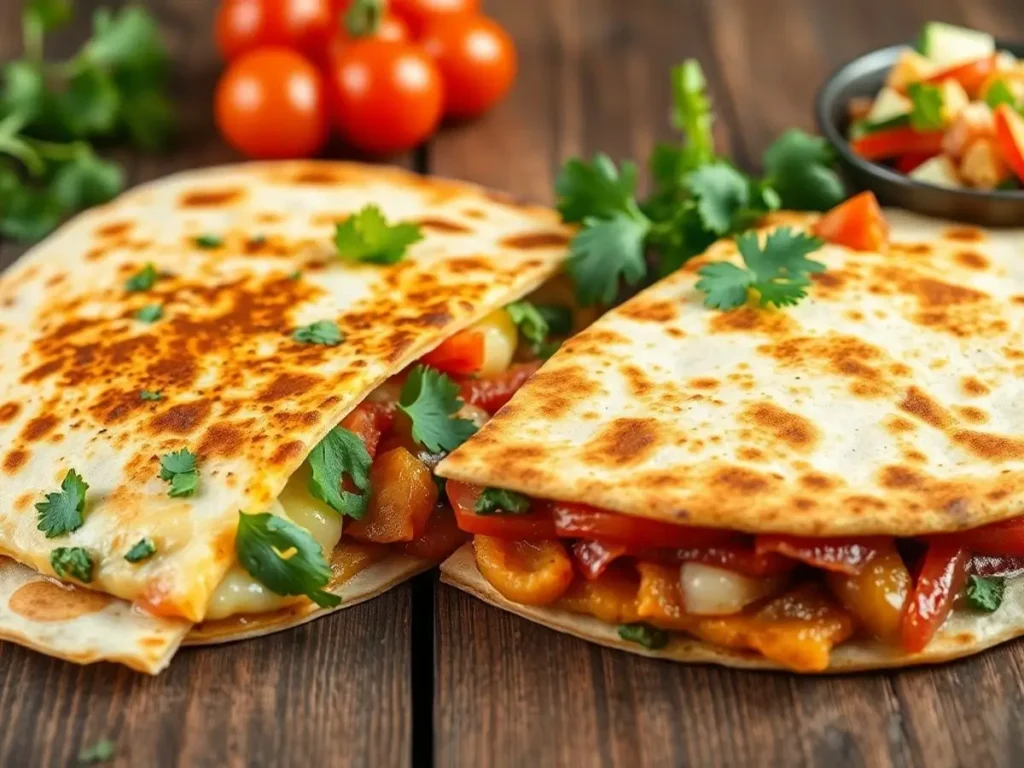Ever wondered what makes Mexican quesadillas and American quesadillas different? Sure, they both have tortillas and cheese, but there’s so much more to it. From the way they’re cooked to the ingredients used, these two versions of a beloved dish have their own unique twists. Let’s dig into what sets them apart, from their roots to how they’ve evolved today.
Table of contents
Key Takeaways
- Mexican quesadillas often use corn tortillas and can be filled with a variety of ingredients, not just cheese.
- In the U.S., quesadillas are typically made with flour tortillas and lots of cheese, often adding meats and vegetables.
- Cooking methods differ, with Mexican quesadillas traditionally cooked on a comal, while American versions might use a skillet or even a quesadilla maker.
- Culturally, quesadillas hold significant importance in Mexico, while in the U.S., they are a popular and versatile dish enjoyed in various forms.
- Common misconceptions include the idea that all quesadillas must have cheese and that they are the same everywhere.
Origins of Mexican Quesadillas and American Quesadillas

Historical Roots in Mexico
The story of the quesadilla begins in the heart of Mexico, where it was a staple long before the Spanish arrived. Native peoples, like the Aztecs, crafted these delightful treats using corn tortillas. Northern Mexico saw the introduction of flour tortillas, which became popular due to the availability of wheat. Over time, this basic food evolved, blending local traditions with new influences.
Influence of Spanish Cuisine
When the Spanish set foot in Mexico, they brought along their culinary traditions. This led to a fascinating connection between foods, merging indigenous ingredients with European techniques. Cheese, particularly Oaxaca cheese, started appearing in quesadillas, adding a rich, creamy texture that many now associate with the dish.
Evolution in the United States
Across the border, the quesadilla took on a life of its own. In the southwestern United States, it became a comfort food, similar to a grilled cheese sandwich but with a twist. Flour tortillas filled with cheese and other ingredients are often baked on a sheet pan, reflecting the American style of baking. This change shows the main difference between the two: while Mexican quesadillas focus on simplicity, American versions celebrate variety and creativity.
To better understand how Mexican cuisine evolved, take a look at Exploring the Origins of Tacos: Traditional vs. Modern Takes.
Quesadillas have journeyed from humble beginnings to become a symbol of culinary fusion, bridging cultures and palates across continents.
Whether you prefer the traditional Mexican style or the innovative American take, there’s no denying the quesadilla’s global influence.
Ingredients That Define Mexican Quesadillas and American Quesadillas
Traditional Mexican Ingredients
Mexican quesadillas are a classic Mexican dish, often made with either corn or flour tortillas. The filling is usually simple, focusing on the rich flavors of Oaxaca or Mexican cheese. Sometimes, black beans, squash blossoms, or even huitlacoche (corn fungus) might find their way into the mix. In various regions, you might find quesadillas that include regional specialties, giving each bite a unique taste of the local culture.
American Adaptations
In the United States, quesadillas have taken on a life of their own. The primary difference here is the use of flour tortillas as a standard. American quesadillas often resemble a grilled cheese sandwich, with Monterey Jack or Cheddar cheese as the star. Additional fillings like bell peppers, onions, and meats such as chicken or beef are common. It’s a meal that offers comfort food vibes, often served with sides like salsa or guacamole.
Regional Variations
Across different regions, both Mexican and American quesadillas showcase slight differences in their ingredients. In Northern Mexico, for instance, flour tortillas are more prevalent. In the U.S., quesadillas often showcase a variety of creative fillings, ranging from goat cheese and spinach to dessert options like chocolate and brown sugar. These variations highlight the connection between foods and cultures, blending traditional elements with modern twists.
For more inspiration on authentic Mexican dishes, check out What Are Other Great Mexican Recipes Beyond Tacos?.
The art of making a quesadilla, whether Mexican or American, lies in the balance of flavors and textures, making it a beloved dish worldwide.
Cooking Techniques for Mexican Quesadillas and American Quesadillas
Traditional Mexican Methods
Mexican quesadillas are a staple in Mexican cuisines, often cooked on a comal, a flat griddle that gives the tortilla its signature crispiness. The process is straightforward: a corn tortilla is warmed until pliable, filled with Oaxaca cheese, and folded. The comal ensures an even cook without needing oil, keeping the quesadilla light and crispy. Some varieties, known as “quesadillas fritas,” are fried to achieve a golden, crunchy exterior. The primary difference between these methods lies in the texture of the final product.
Modern American Approaches
American quesadillas have taken a different path, often using flour tortillas and a wider variety of fillings. A key difference is the cooking method: cheese and other ingredients are placed between two tortillas and baked or grilled on a sheet pan or skillet. This technique creates a crispy outside and a gooey inside. Baking also offers a hands-off option, perfect for busy evenings. American versions often include grilled chicken or beef, making it a hearty comfort food.
Use of Cooking Appliances
In both Mexican and American kitchens, appliances like quesadilla makers or ovens are becoming more common. These tools simplify the cooking process by applying heat evenly from both sides, ensuring the cheese melts perfectly. The baking process in an oven can be particularly useful when preparing large batches, as it allows multiple quesadillas to cook simultaneously. The use of appliances is a modern twist that aligns with the busy lifestyle of many today, providing a quick and easy way to enjoy this beloved dish.
To learn more about diverse baking approaches for comfort foods, visit Baking Techniques for Perfect Calzones and Pizza.
While the essence of a quesadilla remains the same, the methods of preparation reflect the diverse culinary influences and the connection between foods from different regions. Whether using a comal or a baking sheet, the quesadilla continues to be a versatile dish that adapts to various tastes and preferences.
Cultural Significance of Mexican Quesadillas and American Quesadillas

Role in Mexican Cuisine
Mexican quesadillas are more than just a meal; they represent a significant part of Mexican food history. Traditionally, cooks made them with corn tortillas, a staple food for the indigenous people of Mexico. In Mexico City, quesadillas often feature fillings like squash blossoms or huitlacoche, reflecting the region’s rich farming heritage.
These quesadillas are usually cooked on a comal, a flat griddle that enhances the flavors. In Mexican food culture, quesadillas are a favorite comfort food that connects people to their roots and traditions.
Popularity in American Culture
In the United States, quesadillas have taken on a life of their own. They’re a go-to comfort food, often served with cheese slices and a variety of fillings. The American version typically uses flour tortillas, and you might find them stuffed with everything from chicken to mushrooms. They’re quick to prepare and serve as a perfect snack or meal. The influence of Mexican quesadillas is evident, yet the American adaptations have carved out their own niche in the culinary world.
Global Influence
Quesadillas have crossed borders and oceans, becoming a global phenomenon. While the basic food remains the same, each culture adds its twist. From using local cheeses to incorporating unique spices, the quesadilla is a versatile dish that adapts to different tastes. The connection between foods from different regions is evident in how the quesadilla has evolved worldwide. In many places, it’s seen as a brain food, offering a quick and satisfying meal option that’s both tasty and nutritious.
The quesadilla, whether Mexican or American, tells a story of cultural blending and adaptation. It reflects how foods can transcend borders, yet still hold onto their origins. Whether you’re enjoying one in the bustling streets of Mexico City or at a diner in the U.S., you’re tasting a piece of culinary history.
Common Misconceptions About Mexican Quesadillas and American Quesadillas

Cheese as a Standard Ingredient
Many folks assume that cheese is always a must in quesadillas. The name “quesadilla” does suggest a cheesy affair, but in Mexico City, you might actually need to ask for cheese. In other parts of Mexico, cheese is a given, but the type varies. Oaxacan cheese is a popular choice, unlike the cheese slices often found in American versions.
Differences in Tortilla Types
Tortillas are another area where people get mixed up. Mexican quesadillas often use corn tortillas, while American ones tend to go for flour. This choice affects the texture and flavor, adding to the key differences between the two styles.
Misunderstandings in Naming
There’s also confusion with dishes like the sincronizada, which is similar to a quesadilla but not quite the same. In Mexico, it’s a different dish altogether, but tourists often call it a quesadilla. This mix-up highlights the slight differences in how these foods are viewed in different cultures.
Quesadillas are more than just a simple comfort food. They reflect a rich tapestry of regional flavors and traditions, bridging gaps between cultures and cuisines.
Popular Variations of Mexican Quesadillas and American Quesadillas
Mexican Regional Specialties
Mexican quesadillas come in many varieties, reflecting the country’s rich food traditions. In central and southern regions, they are often made with corn masa tortillas, filled with Oaxaca cheese, and cooked on a comal. But that’s just the start. Different areas use unique fillings like squash blossoms, huitlacoche, or chicharron. In the north, flour tortillas are more common, usually filled with Chihuahua cheese. These styles show how local ingredients and traditions shape each quesadilla.
American Fusion Creations
In the U.S., quesadillas have taken on a life of their own, becoming a beloved comfort food. American quesadillas often feature flour tortillas loaded with a mix of cheeses like Monterey Jack or Cheddar. But the creativity doesn’t stop there. Restaurants and home cooks alike experiment with fillings, adding everything from grilled chicken and peppers to goat cheese and spinach. The fusion doesn’t end with savory options—dessert quesadillas with chocolate or caramel are a sweet twist.
Innovative Fillings and Toppings
Whether in Mexico or the U.S., quesadillas inspire creativity. Fillings range from classic beans and cheese to bold choices like tofu or seafood. Toppings add even more flavor, with options like avocado, salsa, or guacamole. Some people even mix quesadilla methods with pizza toppings to create the fun “pizzadilla.” Each version, whether basic or fancy, shows how flexible the quesadilla is as a favorite food.
Just as people experiment with cookie recipes, quesadilla fillings have no limits. For a sweet treat alternative, explore the Crumbl Cookie Recipe: Ultimate Guide.
The quesadilla’s journey from a simple cheese-filled tortilla to a canvas for culinary creativity illustrates its universal appeal. Whether enjoyed in a traditional or modern style, it’s a dish that continues to bring people together over shared flavors and experiences.
Conclusion
So, there you have it. Mexican and American quesadillas might share a name, but they’re like distant cousins at a family reunion. Mexican quesadillas are all about tradition, with their corn tortillas and Oaxaca cheese, sometimes even skipping the cheese altogether in Mexico City.
Meanwhile, American quesadillas have taken a more flexible approach, often using flour tortillas and a variety of cheeses and fillings. Both versions have their own charm and flavor, reflecting the cultures they come from. Whether you prefer the authentic taste of Mexico or the creative twists found in the U.S., quesadillas offer something for everyone. Next time you’re in the mood for one, maybe try a bit of both and see which side of the border your taste buds prefer!
Frequently Asked Questions
What is the main difference between Mexican and American quesadillas?
Mexican quesadillas often feature corn tortillas and may not always include cheese, especially in Mexico City. In contrast, American quesadillas typically use flour tortillas and are filled with cheese along with other ingredients like meat and vegetables.
Do Mexican quesadillas always have cheese?
No, in some parts of Mexico, especially Mexico City, quesadillas might not have cheese unless you ask for it. This is different from other regions where cheese is a common ingredient.
What types of cheese are used in quesadillas?
Mexican quesadillas often use Oaxaca cheese, which is similar to mozzarella. American quesadillas might use Monterey Jack, Cheddar, or Colby Jack cheese.
Can quesadillas have other fillings besides cheese?
Yes, both Mexican and American quesadillas can have various fillings like meats, vegetables, and even beans. In Mexico, you might find ingredients like squash blossoms and mushrooms.
How are quesadillas cooked?
Cooks traditionally prepare Mexican quesadillas on a flat griddle called a comal. In contrast, cooks in the U.S. might prepare quesadillas on a griddle or use a quesadilla maker.
Are there sweet versions of quesadillas?
Yes, there are dessert quesadillas that can include ingredients like chocolate, caramel, and fruits.
